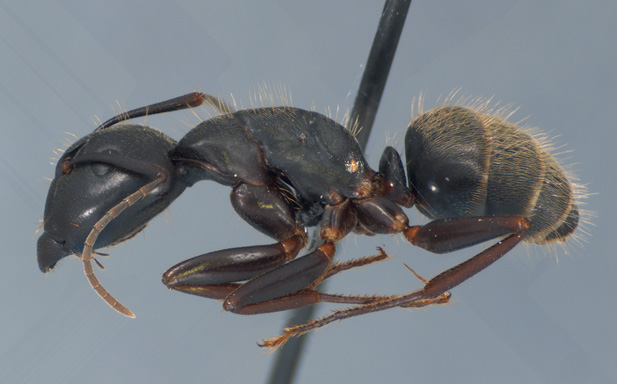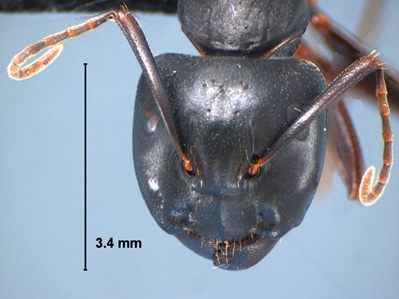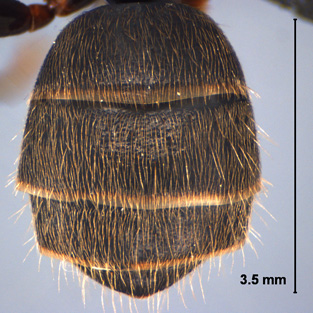Subfamily FORMICINAE |
|
 |
 |
Camponotus pennsylvanicus, profile view of major worker showing typical black coloration. |
Camponotus pennsylvanicus, full face view of a major worker. |
 |
|
Camponotus pennsylvanicus, profile view of major worker. |
Camponotus pennsylvanicus, dorsal view of gaster. Note the pubescence at edges of tergites do not extend far beyond those edges to the next tergite (compare to C. chromaiodes gaster). |
Ants in the genus Camponotus are collectively known as carpenter ants because some species nest in wood, including man-made structure. This genus includes some of the largest and most common ants in the world, and they are found in all biogeographical regions (Bolton, 1995). More than 900 species of Camponotus are known worldwide, with 50 species reported from the United States (Hanson and Klotz, 2005), and 20 species found east of the Mississippi River (Deyrup, 2003; Smith, 1979). Species in this genus are variable in size with workers ranging in size from 3 to 15 mm or more in length and queens (also referred to as females) of some species attaining a length of 19 mm or more. Many species are polymorphic. Workers have a 12-segmented antenna that lacks an apical club. Antennal fossae do not touch the posterior border of the clypeus. Ocelli are not present on the heads of workers. The workers of most species have an indistinct metanotal suture between the promesonotum and the propodeum, although this suture is present in C. sexguttatus and some members of the subgenus Colobopsis. Those species that lack the obvoius and deep metanotal suture have the shape of the alitrunk in a smoothly curved arc (as seen in profile). Camponotus pennsylvanicus is in the subgenus Camponotus, which includes some of the true carpenter ants that nest in wood. Species in this subgenus are large ants with workers ranging approximately 6-14 mm in length. The clypeus is ecarinate to only scarcely carinate, antennal scapes are not flattened at the bases, clypeal fossae are well developed, and the heads of major workers are usually broader than long. This subgenus includes three species in Mississippi. Camponotus pennsylvanicus, commonly referred to as the black carpenter ant, is a large, (6-13 mm long). All castes of this species, including the major and minor workers, queens, and males, are black or blackish, although some specimens have dark, reddish-brown coloration on the propodeum, petiole, base of gaster, or bases of legs. Numerous erect hairs are present on the dorsal surface of the alitrunk, petiole, and the entire surface of the gaster. Appressed pubescence is sparse on most surfaces of the body, although fairly abundant on the dorsum of the alitrunk, somewhat scattered on the side of the propodeum, and very abundant and long on the gaster. The appressed hairs on the gaster are longer than elsewhere on the body (almost as long as the erect hairs), and most of the hairs overlap bases of hairs positioned more posteriorly. Some workers of Camponotus pennsylvanicus are similar to dark colored specimens of C. chromaiodes. Camponotus chromaiodes usually has enough reddish color on the posterior portion of the alitrunk to distinguish it from C. pennsylvanicus, but examination of the appressed hairs on the gastral dorsum is sometimes necessary for identification. In C. pennsylvanicus the appressed hairs on the gaster are silvery-white, relatively numerous, and barely overlap the posterior edges of the gastral tergites, with usually much less than a third of the total hair length extending past the edge, whereas in C. chromaiodes, these hairs are golden colored, very numerous, and overlap the posterior margins of the gastral tergites by at least half of their lengths. This is a very common ant that nests in live and dead trees, rotting logs and stumps, and in wood products such as fences, telephone poles, buildings, and sometimes in the soil. Mature nests may have several thousand workers. We have observed individuals of the eastern ant cricket, Myrmecophilus pergandei Bruner, which is associated with a variety of species, in several different colonies of C. pennsylvanicus. Giant bark aphids, Longistigma caryae (Harris), have also been observed in a black carpenter ant colony. Due to their habit of nesting in man-made structures, this species can cause serious damage making it a serious economic pest. Alates have been collected in AL and MS from mid spring through the Fall. |
|
LINKS AntWeb Images Fact sheet: http://www.ext.vt.edu/departments/entomology/factsheets/carpants.html |
|



